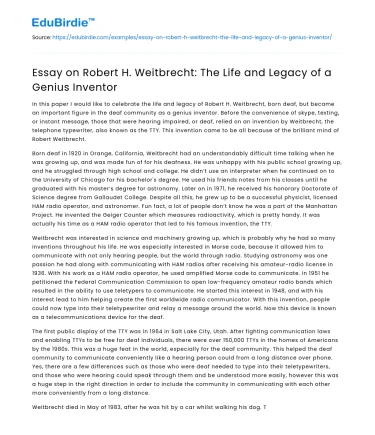In this paper I would like to celebrate the life and legacy of Robert H. Weitbrecht, born deaf, but became an important figure in the deaf community as a genius inventor. Before the convenience of skype, texting, or instant message, those that were hearing impaired, or deaf, relied on an invention by Weitbrecht, the telephone typewriter, also known as the TTY. This invention came to be all because of the brilliant mind of Robert Weitbrecht.
Born deaf in 1920 in Orange, California, Weitbrecht had an understandably difficult time talking when he was growing up, and was made fun of for his deafness. He was unhappy with his public school growing up, and he struggled through high school and college. He didn’t use an interpreter when he continued on to the University of Chicago for his bachelor's degree. He used his friends notes from his classes until he graduated with his master’s degree for astronomy. Later on in 1971, he received his honorary Doctorate of Science degree from Gallaudet College. Despite all this, he grew up to be a successful physicist, licensed HAM radio operator, and astronomer. Fun fact, a lot of people don’t know he was a part of the Manhattan Project. He invented the Geiger Counter which measures radioactivity, which is pretty handy. It was actually his time as a HAM radio operator that led to his famous invention, the TTY.
Save your time!
We can take care of your essay
- Proper editing and formatting
- Free revision, title page, and bibliography
- Flexible prices and money-back guarantee
Weitbrecht was interested in science and machinery growing up, which is probably why he had so many inventions throughout his life. He was especially interested in Morse code, because it allowed him to communicate with not only hearing people, but the world through radio. Studying astronomy was one passion he had along with communicating with HAM radios after receiving his amateur-radio license in 1936. With his work as a HAM radio operator, he used amplified Morse code to communicate. In 1951 he petitioned the Federal Communication Commission to open low-frequency amateur radio bands which resulted in the ability to use teletypers to communicate. He started this interest in 1948, and with his interest lead to him helping create the first worldwide radio communicator. With this invention, people could now type into their teletypewriter and relay a message around the world. Now this device is known as a telecommunications device for the deaf.
The first public display of the TTY was in 1964 in Salt Lake City, Utah. After fighting communication laws and enabling TTYs to be free for deaf individuals, there were over 150,000 TTYs in the homes of Americans by the 1980s. This was a huge feat in the world, especially for the deaf community. This helped the deaf community to communicate conveniently like a hearing person could from a long distance over phone. Yes, there are a few differences such as those who were deaf needed to type into their teletypewriters, and those who were hearing could speak through them and be understood more easily, however this was a huge step in the right direction in order to include the community in communicating with each other more conveniently from a long distance.
Weitbrecht died in May of 1983, after he was hit by a car whilst walking his dog. The deaf community mourned his passing, having been grateful for his successes and invention of the TTY. His invention helped to create a more convenient lifestyle in the world of communication for the community, and his brilliant mind will always be remembered.
Works Cited
- Discoveries: Significant Contributions of Deaf Women and Men by Anita P. Davis, Katharine S. Preston. Published 1996, reprinted 2005, authored by Anita Davis and Katharine.
- Slemenda by Butte Publications. Great Deaf Americans: The second Edition. Matthew S. Moore and Robert F. Panara. Chapter 24 is about Robert Weitbrecht.
- “Robert H. Weitbrecht”. Deaf Scientist Corner, http://twu.edu/dsc/weibrechtI.htm.
- “Robert H Weitbrecht”. Historytrendsanddeafeducation, Robert H Weitbrecht. http://historytrendsanddeafeducation.pbworks.com/w/page/18570694/Robert%20H%20Weitbrecht






 Stuck on your essay?
Stuck on your essay?

